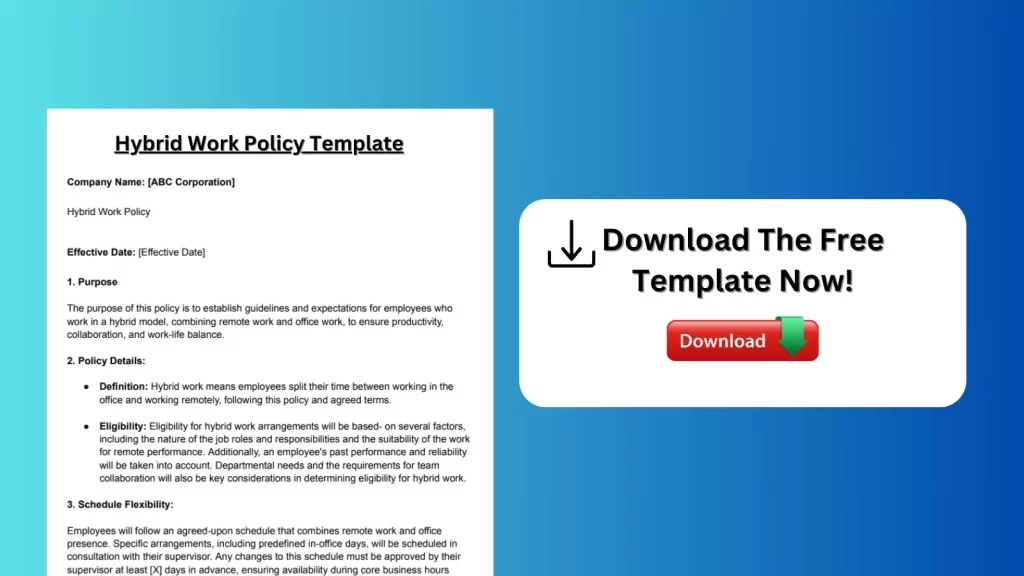The hybrid work model has emerged as a pivotal strategy for organizations aiming to balance remote and in-office work. As companies adapt to new operating methods, the hybrid work policy stands out as a vital framework that fosters flexibility, enhances productivity, and supports employee well-being.
However, implementing an effective hybrid work policy has unique challenges requiring thoughtful planning and consideration.
This guide aims to delve into the essential steps and key considerations involved in crafting such a policy. By understanding these intricacies, organizations can foster a productive, inclusive, and adaptable work environment that meets the needs of employees and the business.
LISTEN TO THE PODCAST NOW!
What’s A Hybrid, Remote, Or Flexible Work Policy?
A hybrid, remote, or flexible work policy outlines employees’ flexibility regarding their Work location and Working hours.
A remote work policy covers working hours, legal conditions, cybersecurity requirements, as well as employee rights and company benefits.
Similarly, a hybrid work policy includes all remote work details but also addresses office-related matters such as desk booking and minimum office attendance requirements.
A flexible work policy encompasses both remote and hybrid aspects, emphasizing employees’ work-life balance- have to set their working hours and choose their work location.
In practice, these terms are- often used interchangeably. The shift towards work-from-anywhere policies reflects a growing trend shaping future work environments.
The Importance And Advantages Of Hybrid Work Policies
Numerous companies implement hybrid work models to offer employees the flexibility and autonomy of remote work while also boosting in-person teamwork and collaboration. However, without a clearly defined hybrid work policy, expectations and requirements for hybrid work may be ambiguous, leading to potential disruptions in employee engagement, retention, and productivity.
Listed below are some of the benefits of having a documented hybrid work policy:
- Improved clarity and transparency concerning the expectations and prerequisites of hybrid work.
- Reduction in misconceptions and misunderstandings about work schedules and protocols.
- Reducing bias through the implementation of consistent hybrid work requirements across departments and teams.
- Increased employee motivation and engagement by outlining the rationale behind hybrid work arrangements, such as opportunities for team collaboration.
- Improved adherence to legal requirements and risk management by ensuring compliance with labor laws, regulations, and employment standards.
9 Things To Include In Your Hybrid-Working Policy
Before 2020, the adoption of hybrid working practices progressed slowly within organizations.
Hybrid working is poised to increase in popularity over the next 12 to 18 months. Major organizations have already embraced hybrid-working policies, though the model remains imperfect and requires ongoing optimization and monitoring.
While a universal approach to hybrid working would simplify matters, customization and adaptation based on organizational needs are essential. Below, we explore key areas to consider when formulating your hybrid-working policy.
1. Process:
Hybrid working falls under flexible working policies, which likely already exist within your organization. Adapting or updating these policies to encompass hybrid working may be feasible, but significant differences may exist between modern hybrid work models and pre-2020 flexible work policies.
Previously, flexible working requests were often individual; however, the demand for hybrid working- is expected to be widespread. Therefore, your hybrid work policy may require customization at the team level based on your organization’s structure and specific circumstances.
Before drafting or revising your hybrid policies, it’s crucial to:
- Understand how hybrid-working policies interact with other flexible working arrangements such as agile, part-time, and remote work.
- Outline the process for employees to request hybrid working.
- Determine eligibility criteria and varying levels of flexibility among roles.
- Review and align other policies affected by hybrid working, including IT usage, data protection, and expense management.
- Define roles and responsibilities for both hybrid workers and management.
2. Legal Implications Of Hybrid Working:
While hybrid working offers- benefits for employees and employers, it introduces legal considerations that require careful management. Employers must ensure the health and safety of remote workers as rigorously as office-based employees. Contractual implications, such as defining work locations in employee contracts, also require attention.
3. Communication:
Effective communication is vital for successful hybrid working. Reduced face-to-face interaction and informal discussions can lead to communication gaps and a disjointed workplace culture. Establishing clear communication channels and encouraging inclusive practices can mitigate these challenges.
Recommendations for fostering effective communication include:
- Organizing regular virtual and in-office social events to promote team building.
- Utilizing communication platforms and asynchronous tools to facilitate flexible interaction.
- Encouraging teams to establish communication norms suitable for their roles and organization size.
- Ensuring all communication is inclusive and accessible to remote employees.
4. Manager Training And Development:
While many managers and senior employees have adapted to managing remote teams during the pandemic, handling a fully hybrid workforce presents unique challenges.
Organizations must prioritize learning and development to ensure managers are equipped to lead their teams effectively in this new working environment.
Key areas of focus for training and development in hybrid working include:
- Enhancing communication skills
- Implementing effective performance management
- Fostering team building
- Promoting collaboration
- Managing hybrid working requestsEnsuring inclusion and diversity
- Boosting employee engagement
- Streamlining effective onboarding
5. Technology And Equipment:
Technology plays a pivotal role in facilitating hybrid work arrangements. By equipping teams with suitable tools and training, organizations ensure smooth communication and collaboration even across dispersed teams, all while safeguarding data security and integrity. Integrating employee monitoring software like EmpMonitor can enhance these capabilities by offering comprehensive monitoring and management solutions, thereby ensuring productivity and compliance across remote and on-site work environments.
6. Employee Wellbeing:
Hybrid working can enhance employee well-being by offering flexibility and reducing commute times. However, it also presents challenges such as managing work-life balance and maintaining mental health. Supporting employees with well-being programs and promoting healthy technology usage are crucial.
7. Performance Management:
Performance metrics should prioritize outcomes and deliverables over hours worked, adapting conventional performance management practices to accommodate remote and hybrid work environments. Utilizing the EmpMonitor tool can facilitate this transition by providing insights into productivity, task completion rates, and overall performance trends. Such tools help in tracking remote workers’ activities, ensuring accountability based on results rather than mere presence or logged hours. Enabling organizations to manage performance within a flexible work environment adeptly.
8. Inclusion And Equality:
Ensuring equal opportunities and inclusivity for all employees, regardless of their work location, is essential. Addressing potential biases and actively including remote workers in organizational activities and development opportunities is vital.
9. Employee Lifecycle:
Adapting the employee lifecycle- from recruitment to career development- to accommodate hybrid working ensures consistency and fairness across all stages of employment.
Integrating these factors into your hybrid working policy can effectively foster a supportive and productive environment that aligns with the evolving needs of employees and the organization. Furthermore, leveraging the EmpMonitor tool can enhance this process by providing valuable insights into employee productivity, remote work patterns, and collaboration dynamics.
EmpMonitor: Workforce Management Software
EmpMonitor enhances organizational efficiency by providing comprehensive insights into workforce activities. It supports both remote and in-office employee monitoring, promoting operational transparency and regulatory compliance. It enables businesses to optimize resource utilization and make informed decisions, contributing to overall productivity and success in competitive markets.
EmpMonitor offers a comprehensive suite of features that empower employers to effectively monitor and manage their remote workforce while respecting privacy and fostering trust.
- Real-Time Activity Monitoring: EmpMonitor offers real-time insights into employees’ activities, such as visited websites, utilized applications, and task durations. This feature aids managers in tracking productivity trends and pinpointing potential bottlenecks.
- Screenshots: For enhanced transparency and accountability, EmpMonitor captures screenshots at predefined intervals or upon specific triggers. This feature aids in verifying work progress and adherence to company policies.
- Time Tracking And Attendance: The software tracks work hours, breaks, and attendance automatically. It generates reports detailing employee attendance patterns and helps ensure accurate payroll processing.
- Productivity Analysis: EmpMonitor analyzes employees’ productive hours versus idle time, providing actionable insights to optimize workflow and resource allocation.
- Keystroke Logging: This feature records keystrokes to analyze employee input, helping to understand task completion and improve operational efficiency.
EmpMonitor empowers organizations with insightful hybrid workforce monitoring solutions, fostering productivity and compliance in remote and office environments. Promoting transparency and efficient resource allocation enables businesses to make informed decisions and succeed in competitive markets.
How To Create A Hybrid Work Policy?
Creating a hybrid work policy involves developing a structured framework that outlines how employees will balance remote work and office attendance. Here’s a detailed explanation of the steps involved:
Assess Work Roles And Responsibilities:
Begin by analyzing the roles and responsibilities within your organization. Identify which positions benefit from in-person collaboration and which can effectively operate remotely. This assessment helps determine the frequency and flexibility of office attendance for different teams or individuals.
Develop Clear Communication Guidelines:
Effective communication is crucial in a hybrid work environment where teams- are geographically dispersed. Establish clear guidelines on how communication will be conducted- across different channels (email, messaging apps, video conferencing), including expectations for response times and meeting protocols. It’s essential to ensure all team members, whether in-office or remote, feel included and informed.
Implement Technology And Security Measures:
Equip employees with the necessary technology and tools to facilitate seamless collaboration between remote and in-office workers. It includes providing secure access to company systems, ensuring data protection measures are in place, and offering IT support for troubleshooting. Addressing cybersecurity concerns is critical to protect sensitive company information accessed from various locations.
Establish Performance And Productivity Benchmarks:
Define clear performance metrics and productivity benchmarks that align with organizational goals. This step involves setting measurable objectives for individual employees and teams, tracking progress regularly, and providing constructive feedback. Performance evaluations should focus on outcomes rather than hours worked to accommodate the flexibility of hybrid work arrangements.
Address Health And Safety Concerns:
Ensure the health and safety of employees in both office and remote settings. Implement protocols for office cleanliness, ergonomic workstations, and mental health support. Provide guidelines for handling health-related issues, including sick leave policies and resources for maintaining work-life balance.
Leave Room For Flexibility:
Hybrid work policies should allow for flexibility to accommodate varying employee needs and preferences. Offer options for adjusting work schedules, choosing work locations (home vs. office), and managing personal commitments. Flexibility promotes employee satisfaction and enhances work-life balance, contributing to overall productivity.
By following these steps and tailoring them to your organization’s- specific needs, you can create a comprehensive hybrid work policy that supports employee engagement, collaboration, and organizational success in a flexible work environment.
Hybrid Work Policy Template
Here’s a free template for a hybrid work policy:
5 Examples Of Hybrid Work Models
Curious about different hybrid work models and which might suit your business best? Here are five variations of hybrid work policy examples of companies:
#1: Required Office Attendance With Flexibility Days
Under this model, prioritizing office work remains essential, though employees also have the option to work remotely on occasion.
Example: Goldman Sachs emphasizes the importance of in-office collaboration- with CEO David Solomon stating in an interview with Fortune magazine that remote work is seen as an aberration to be corrected swiftly. While office presence is preferred, flexible work arrangements can be arranged- by individual managers upon request.
#2: Office-First With Optional Remote Work
In this model, most employees primarily work from the office but have the flexibility to occasionally work from home.
Example: At JP Morgan, employees are required to work from the company office three days a week, with the option to work from home during the remaining days. The majority of their workforce does not work remotely full-time, as recently announced by the company for its senior staff.
#3: Hybrid (50/50 Split)
A hybrid model offers employees the flexibility- to split their work time equally between office and remote locations.
Example: Microsoft recognizes the diversity in employee work preferences and allows flexibility under its hybrid work policy. Employees can choose their preferred work location, whether at home or in the office and discuss optimal work hours with their managers based on job requirements.
#4: Remote-First With Office Options
In this model, remote work is the default, but the office remains open for occasional use or specific events.
Example: Atlassian adopts a remote-first approach, giving employees full control over where and when they work. Employees can- choose to work remotely from any location, reflecting Atlassian’s commitment to flexibility and work-life balance.
#5: Fully Remote With Limited Office Days
Employees primarily work from home, with occasional office visits required for specific purposes.
Example: Salesforce offers its office-based employees the option to work from home full-time, attending the office only for special company events. Salesforce promotes a flexible work culture beyond traditional office hours, focusing on enhancing the overall employee experience.
This sample hybrid work policy exemplifies how organizations can embrace flexibility and adaptability to meet diverse employee needs, all while optimizing productivity and enhancing collaboration.
ALSO READ:
Managing A Hybrid Workforce With Employee Monitoring Software
Hybrid Workforce: The New Era Of The Work Model
Coffee Badging: The New Workplace Trend You Need To Know About
Hybrid Remote Meaning: How It Works & Why Companies Love It?
Hybrid Success Is Almost Here
Creating a hybrid work policy requires careful consideration of various factors to ensure it meets organizational needs and employee expectations. Tools like EmpMonitor can assist in monitoring and managing remote work effectively.
Flexibility and adaptability are key to maintaining a cohesive and efficient hybrid work environment. As businesses navigate this evolving landscape, a well-crafted hybrid work policy, supported by tracking software like EmpMonitor, serves as a foundation for success in the future of work.
FAQs
1. What is a hybrid work policy?
A hybrid work policy is a flexible working arrangement that combines remote work and in-office work. Employees divide their time between working remotely (from home or another location) and the company’s office.
2. Why are we adopting a hybrid work policy?
We are adopting a hybrid work policy to enhance employee work-life balance, increase productivity, and adapt to changing workplace dynamics. It also helps reduce commute times and office space needs.
3. What are the benefits of a hybrid work policy?
Employees report several benefits from a hybrid work policy, including improved work-life balance, increased focus with fewer distractions, more time for family, friends, and personal well-being activities, saved commuting time and costs, and higher levels of motivation and engagement.
4. How can we create a hybrid work policy?
To create a hybrid work policy, clearly define where, when, and how employees can work. Include best practices for all employees, specify which roles and employees are eligible for hybrid work, and outline the legal rights of hybrid employees.















